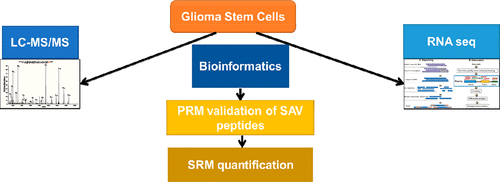当前位置:
X-MOL 学术
›
ACS Chem. Neurosci.
›
论文详情
Our official English website, www.x-mol.net, welcomes your feedback! (Note: you will need to create a separate account there.)
Large Scale Identification of Variant Proteins in Glioma Stem Cells
ACS Chemical Neuroscience ( IF 5 ) Pub Date : 2017-12-21 00:00:00 , DOI: 10.1021/acschemneuro.7b00362 Ekaterina Mostovenko 1 , Ákos Végvári 2 , Melinda Rezeli 2 , Cheryl F. Lichti 1, 3 , David Fenyö 4 , Qianghu Wang , Frederick F. Lang , Erik P. Sulman , K. Barbara Sahlin 2 , György Marko-Varga 2 , Carol L. Nilsson 5
ACS Chemical Neuroscience ( IF 5 ) Pub Date : 2017-12-21 00:00:00 , DOI: 10.1021/acschemneuro.7b00362 Ekaterina Mostovenko 1 , Ákos Végvári 2 , Melinda Rezeli 2 , Cheryl F. Lichti 1, 3 , David Fenyö 4 , Qianghu Wang , Frederick F. Lang , Erik P. Sulman , K. Barbara Sahlin 2 , György Marko-Varga 2 , Carol L. Nilsson 5
Affiliation

|
Glioblastoma (GBM), the most malignant of primary brain tumors, is a devastating and deadly disease, with a median survival of 14 months from diagnosis, despite standard regimens of radical brain tumor surgery, maximal safe radiation, and concomitant chemotherapy. GBM tumors nearly always re-emerge after initial treatment and frequently display resistance to current treatments. One theory that may explain GBM re-emergence is the existence of glioma stemlike cells (GSCs). We sought to identify variant protein features expressed in low passage GSCs derived from patient tumors. To this end, we developed a proteomic database that reflected variant and nonvariant sequences in the human proteome, and applied a novel retrograde proteomic workflow, to identify and validate the expression of 126 protein variants in 33 glioma stem cell strains. These newly identified proteins may harbor a subset of novel protein targets for future development of GBM therapy.
中文翻译:

胶质瘤干细胞中的变异蛋白的大规模鉴定
胶质母细胞瘤(GBM)是原发性脑肿瘤中最恶性的一种疾病,具有毁灭性和致命性,尽管采取了根治性脑肿瘤手术,最大的安全放疗和伴随化疗的常规方案,但从诊断开始的中位生存期为14个月。GBM肿瘤在初始治疗后几乎总是重新出现,并经常表现出对当前治疗的抵抗力。可以解释GBM重新出现的一种理论是神经胶质瘤干样细胞(GSC)的存在。我们试图鉴定在源自患者肿瘤的低代GSC中表达的变异蛋白特征。为此,我们开发了一个蛋白质组学数据库,该数据库反映了人类蛋白质组中的变异和非变异序列,并应用了一种新型的逆行蛋白质组学工作流程,以鉴定和验证126种蛋白质变异在33个神经胶质瘤干细胞株中的表达。
更新日期:2017-12-21
中文翻译:

胶质瘤干细胞中的变异蛋白的大规模鉴定
胶质母细胞瘤(GBM)是原发性脑肿瘤中最恶性的一种疾病,具有毁灭性和致命性,尽管采取了根治性脑肿瘤手术,最大的安全放疗和伴随化疗的常规方案,但从诊断开始的中位生存期为14个月。GBM肿瘤在初始治疗后几乎总是重新出现,并经常表现出对当前治疗的抵抗力。可以解释GBM重新出现的一种理论是神经胶质瘤干样细胞(GSC)的存在。我们试图鉴定在源自患者肿瘤的低代GSC中表达的变异蛋白特征。为此,我们开发了一个蛋白质组学数据库,该数据库反映了人类蛋白质组中的变异和非变异序列,并应用了一种新型的逆行蛋白质组学工作流程,以鉴定和验证126种蛋白质变异在33个神经胶质瘤干细胞株中的表达。



























 京公网安备 11010802027423号
京公网安备 11010802027423号